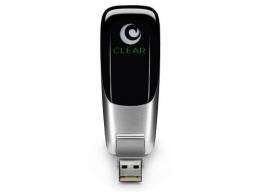Mobile Internet device performs unevenly in debut

If you could take broadband Internet with you, where would you take it? To an airport, a coffee shop or - this being Los Angeles - the beach, where you can surf the Net while watching surfers ride the waves?
Results of recent testing of Clear's new 4G mobile Internet device were, like its coverage area, a little patchy.
The walnut-sized gadget that plugs into a laptop's USB port allows users to swap between 4G and 3G Internet service. But the 4G coverage was lacking in some key areas of Los Angeles County.
Clear, a brand name for wireless company Clearwire Corp., rolled out its mobile Internet service in Los Angeles in November. The service, which taps into Sprint Nextel Corp.'s cellular network, is also available in New York. Clear said it would launch in San Francisco on Dec. 28 and move into San Diego and Sacramento next year, aiming for full coverage nationwide by 2012.
Clearwire's investors include Sprint, Google Inc., Intel Corp. and cable companies Comcast Corp. and Time Warner Cable Inc.
With 4G, or fourth-generation cellular technology, the network can deliver download speeds of 3 to 6 megabits per second - fast enough to allow video and gaming without being physically tethered to, well, anything.
If 4G coverage is not available, the device connects to Sprint's 3G service, which delivers a speed of about 1 Mbps. That's OK for checking e-mail and little Web hits but can be frustratingly slow.
The early rundown on coverage: I got patchy reception in downtown Los Angeles and, somewhat surprisingly, Santa Monica, as well as the Inland Empire. Service was consistently good in Long Beach, northern Orange County, much of the South Bay around Los Angeles International Airport, and in the San Fernando Valley.
It's advisable to check the coverage map Clear offers at its website before deciding to buy. And keep checking, because Clear said it was working quickly to cover an area "from Burbank to Irvine to Ontario."
"We expect to have continually improved coverage over the next couple of months," Clear spokeswoman Debra Havins said. "Airports are a key part of our strategy. Train lines and commuter corridors are very important to us. We've found interest from all ages, small businesses, professionals as well as gamers."
The device is not a hot spot but can be used to power a secondary device that connects multiple users to the Internet.
The setup process was easy and its interface was perfectly functional on both my MacBook Pro and my desktop PC. Download speed was similar to the broadband Internet provided by my cable company.
Clear's gadget retails for $99 with a variety of service plans depending on your Internet usage. Expect to pay about $60 a month for a plan that covers frequent and occasionally heavy Internet use such as streaming videos, and look around for "early adopter" deals Clear is promoting.
If Clear lives up to its word that coverage will improve, I'd consider forgoing a traditional cable or satellite Internet setup in favor of the Clear device. Of course, if you take it on the road, you wouldn't have Internet connectivity at home, a possible problem for those with families or roommates staying behind.
But how many other devices allow you to download high-resolution surfing videos while sitting within 50 yards of actual surfers? Mobile 4G could be the wave of the future, fer sure.
(c) 2010, Los Angeles Times.
Distributed by McClatchy-Tribune Information Services.
















